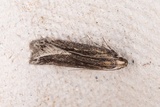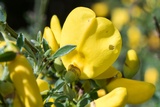Mirificarma mulinella (Zeller, 1839) Species
Last modified: Nov. 30, 2025, 6:21 p.m.
A rare species in Belgium. In some area's in the southern part the species can be locally fairly common.
Details
- Classification
- Family: Gelechiidae > Subfamily: Gelechiinae > Tribus: Gelechiini > Genus: Mirificarma > Species: Mirificarma mulinella
- Vernacular names
- Bremkwastje (NL), Gorse Streak, Gorse Groundling (EN), Ginsterblüten-Palpenmotte (DE)
- First mention in Belgium
- Fologne E. 1862c. Notes sur quelques lépidoptères observés en Belgique. — Annales de la Société entomologique belge 6: 170–176. On page 173.
- Status
-
Native
Distribution
Bionomics
The larva enters the flower-buds before they are fully expanded and eats the interior of the flower, when finished, it changes to a new bud. The flower become distorted and the presence of the larva is revealed by holes in the flowers. When found on Lupinus arboreus it eats the leaves instead of the flowers. Pupation takes place in a slight cocoon among detritus on the ground.
Adults become active from sunset onwards and later come to light.
Flight periods
The adults have been seen from late July towards late September with a peak during August.
Observed on
- Host plant (species):
- Ulex europaeus and Cytisus scoparius
- Host plant (genera):
- Lupinus
The larvae are mainly found on Cytisus scoparius and Ulex europaeus. Further mentioned in literature are Cytisus nigricans and Genista germanica. In Great Britain also found occasionally on Lupinus arboreus.
















